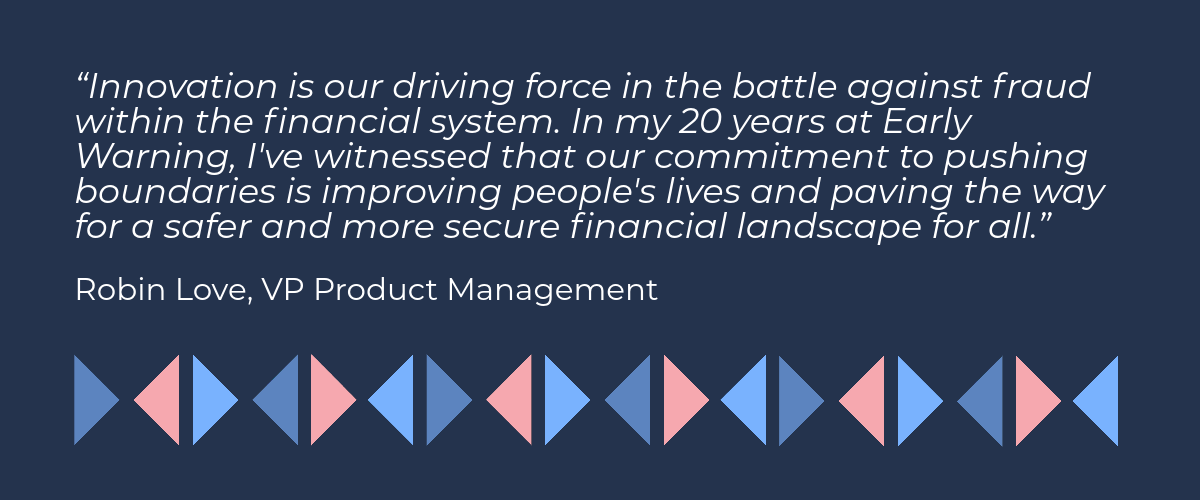For over 30 years, Early Warning® has been at the forefront of bank intelligence, fraud mitigation and digital payment technologies. The company has evolved quite a bit over the past few decades, but one thing remains the same: We are continuously innovating to move banking forward.
In this blog post, we’re sharing a behind-the-scenes look at how Early Warning began, how it’s evolved, and the details of how Early Warning products work today.
Our company’s history spans three decades.
Early Warning was conceived in 1990 when several banks collaborated to create a model to mitigate deposit losses by sharing data. The collaboration led to the formation of an independent company to steward this data on behalf of the banking industry.
In the early-2000s, the company adopted the Early Warning brand and became wholly bank-owned. Today, Early Warning Services, LLC is co-owned by seven major U.S. banks, including Bank of America, Capital One, JPMorgan Chase, PNC Bank, Truist, U.S. Bank and Wells Fargo.
Throughout the years, we have continued to expand and enhance our products and services, which range from fraud risk controls and identity verification to real-time payments. While doing so, we consistently adhere to a rigorous set of rules and regulations to ensure compliance with industry standards and safeguard consumer interests.
“Innovation is our driving force in the battle against fraud within the financial system. In my 20 years at Early Warning, I've witnessed that our commitment to pushing boundaries is improving people's lives and paving the way for a safer and more secure financial landscape for all.” Robin Love, VP Product Management
Data sits at the heart of Early Warning.
Our platform is a holistic solution that combines deep data intelligence with sophisticated analytics to give banks and credit unions the information they need to reduce fraud, improve efficiencies and deliver better banking experiences.
KEY DIFFERENTIATORS
- Robust data: As the Trusted Custodian® of the National Shared DatabaseSM Resource, Early Warning oversees a comprehensive collection of deposit performance data. This valuable resource is made possible through the contribution of data from thousands of financial institutions on a recurring basis, ensuring the data is reliable and up to date.
- Scalable technology: Banks and credit unions can access capability bundles through a single application programing interface (API), allowing them to implement once—and quickly deploy additional capabilities as they grow.
- Rich analytics: Early Warning's risk assessment algorithms incorporate comprehensive, cross-institution data sets, enabling more informed decision-making.
- Proven track record: With a decades-long track record, Early Warning serves a growing network of more than 3,500 banks, credit unions and financial services companies of all sizes, including 45 of the top 50 financial institutions. In 2022, Early Warning alerted financial institutions to $13 billion in high-risk transactions, including 2.7 billion checks screens, 49 million new accounts screened and $1.4 billion in potential check fraud1.
We work with financial institutions and businesses in various ways.
How does Early Warning work with financial institutions?
Thousands of U.S. banks and credit unions partner with Early Warning by contributing data to its National Shared DatabaseSM Resource—and enjoying powerful capabilities in return.
Indeed, Early Warning empowers a vast and growing network of banks and credit unions with the tools, technologies and insights they need to mitigate risk, minimize fraud and deliver better customer experiences.
Early Warning supports banks in facilitating fast, easy and secure payments for the businesses and consumers they serve.
How does Early Warning work with companies?
Early Warning enables companies and online merchants to offer fast, safe and easy payment options to consumers while staying in compliance with regulatory obligations, such as the NACHA Web-Debit Rule. Using products like Verify Account, Zelle® and PazeSM businesses can simplify transactions and foster secure and more personalized relationships with their customers.
Current Early Warning offerings address modern banking needs.
Capability Bundles: Everything on our platform is part of a larger solution. Products and services are bundled according to the capabilities they offer.
- The New Account Opening Capability Bundles allow financial institutions to safeguard against identity fraud and confidently open accounts for a broader population of consumers. Capabilities include identity verification with risk assessments and expanded credit insights for applicants with little or no credit history.
- The Payments & Deposits bundles enable safe and speedy transactions while reducing check and ACH losses—by confirming account ownership and delivering real-time payment and deposit risk notifications.
- Our additional capability bundles allow financial institutions, companies and government entities to differentiate their identity theft solutions and reduce improper benefits payments through real-time responses and accurate alerts.
Zelle Network®: Zelle® is a digital payment network that enables a fast, safe and easy way for people to send and receive money with others they know and trust. Zelle® can be built directly into your online or mobile banking experience meaning there’s no need to download an additional app.
Early Warning offers multiple use cases for Zelle®, as described below:
- Zelle® Person-to-Person (P2P) Payments is a fast, safe and easy way for people to send and receive money with others they know and trust directly from their mobile banking app.
- Zelle® Small Business allows eligible small businesses to improve their cash flow, reduce the need to use cash or checks and send or receive payments on-the-go using a Zelle® enrolled email address or U.S. mobile number. *
*To send or receive money with a small business, both parties must be enrolled with Zelle® directly through their financial institution’s online or mobile banking experience.
- Disbursements with Zelle® allows businesses, government entities and other organizations to disburse payments quickly and securely to consumers for things like insurance claims, refunds and employee reimbursements.
PazeSM: Paze is a new digital wallet that participating banks and credit unions offer to consumers and merchants for online purchases. It is the first digital wallet of its kind that combines eligible cards across all participating financial institutions into a single consumer wallet. Benefits of Paze include:
- Consolidation of consumer cards in a single wallet
- No manual entry of full card details required
- No new passwords or usernames to set up
- No app to download
Early Warning supports consumers with fast and secure banking experiences.
Early Warning makes it fast and easy for individuals to send and receive money safely with people they know and trust. Whether it’s sending money to friends with Zelle® or making online purchases with PazeSM, Early Warning gets money moving fast—so people can get on with their lives.
Consumers also benefit from fast and easy account opening processes. With Early Warning’s account risk controls, financial institutions can assess an applicant’s risk in real-time—and move valid applicants swiftly through the onboarding process.
How does Early Warning work to improve financial inclusion? With broad and deep insights into a consumer’s complete account history and behavior, financial institutions can make more nuanced account opening decisions—to confidently approve more applicants, even those with little to no credit history. Early Warning supports consumers' rights to dispute and correct inaccurate or incomplete consumer reporting information and provides one free report every 12 months, if the consumer requests it.
To learn more about Early Warning or how our products work, visit our website.


